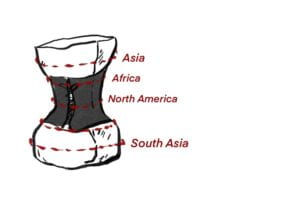I initially have 3 project ideas, on the topics of body anxiety, smoking, and maternal mortality, and I eventually chose the last one as I was shocked by how hugely the ratios of maternal mortality can differ between countries. With European countries like Denmark where the ratio is as low as 1.6/100,000, the ratio in Nigeria is up to 916/100,000, around 570 times larger than that in Denmark. With that being mentioned, a large number of pregnant women, if in developed countries with advanced medical care, could have fought through their difficult labors. While for a lot of preventable reasons, they didn’t. I planned to use blood drops around an operation table to represent the ratios, with a longer drop representing a higher ratio, in a way to not only warn the audience the dramatic inequality between countries but also deliver the cruel message in an impactful and eye-catching way.



The critical making concept emphasizes that artists, instead of producing the comfortable status quo by being efficient and optimized, could critically question the social norms and values by creating something that is opposite. Compared with the concept of critical design that is object-oriented, critical making focuses on the “material production as a site for critical reflection”. My project is focused on one social issue that is oftentimes ignored by the public, the inequality in maternal mortality between countries, in an attempt to increase the awareness in the relevant topic by 3D printing. The process of simulating and printing blood drops artificially in a sense conveys the idea that maternal mortality can be an issue that’s largely dependent on human activities related to the economic and healthcare development and could have been prevented. In addition to the 3D printing, I am also to use red paint as blood and a metal tray as an operation table. The materials chosen is based on my plan to restore the labor scene in real life as much as possible, and the audience can take a close look at the project in different angles to make comparisons between countries, which can be a better involving experience than a digital visualization.
The materials that I currently decide to use is PLA, cloth, a stainless-steel tray, and paints. The fabrication method would be mostly 3D printing but also combined with handmade process and painting.


